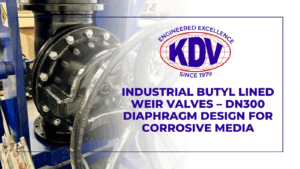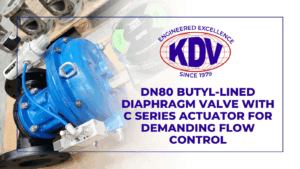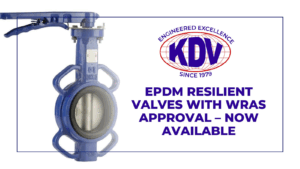Industrial Butyl Lined Weir Valves – DN300 Diaphragm Design for Corrosive Media
Reliable Valve Solutions for Large-Diameter Flow Control
The DN300 butyl lined weir type diaphragm valve is engineered for demanding applications where consistent isolation and chemical resistance are required. Designed for use in large-bore industrial pipelines, this valve helps reduce the risks associated with corrosive and abrasive media.
Operators in sectors such as mining, chemical manufacturing, and water treatment often face premature wear in high-flow systems. The butyl lining provides a stable solution to prolong service life while maintaining tight shut-off performance.
KDV Flow’s extensive experience with diaphragm valve assemblies, including customised builds and international delivery, makes this model a dependable choice for harsh operating conditions.
Technical Details and Dimensional Compliance
The DN300 model is built in accordance with EN 558-1 Series 1 face-to-face standards, ensuring straightforward integration into existing pipework. It is constructed from durable cast iron or stainless steel, with internal surfaces lined using butyl rubber, chosen for its resistance to diluted acids, brine, and abrasive slurry.
Operating pressures typically range between PN10 and PN16, and temperature tolerances are up to 120°C, depending on media and cycle frequency.
View our weir valve body range for compatible options and specifications.
For general information on diaphragm valve construction, refer to Wikipedia’s valve list or this page on weir diaphragm valve design.
Where It Performs Best
DN300 valves of this specification are frequently installed in bulk chemical distribution, industrial wastewater control, and neutralisation systems. These setups often deal with variable pH levels, solids in suspension, or corrosive residues—conditions that benefit from a reliable weir-type closure.
This valve integrates seamlessly into automated valve systems including pneumatic and electric actuation. When incorporated into flow loops or batching stations, the valve offers tight regulation and fast response with low maintenance needs.
For additional use cases, see industrial applications of weir-type diaphragm valves.
Materials and Performance Engineering
The use of butyl rubber gives this model robust chemical compatibility, especially where inorganic acids, alkali solutions, or brine-based effluents are present. It performs better than EPDM in gas permeability scenarios and has stronger abrasion resistance than many PTFE-based linings.
The valve’s weir design protects internal mechanisms from fluid contact, preserving bonnet integrity and simplifying actuator servicing. With fewer moving parts exposed to flow, these valves are especially suitable for sites prioritising uptime and predictability.
Explore our full diaphragm valve range for more size and material options.
For detailed lining properties, see butyl rubber lining chemical resistance.
Installation and Service Considerations
The valve should be installed with proper flange alignment and supported where necessary to prevent pipe strain. Gasket selection should match the media and temperature. Typical maintenance intervals range from 12–18 months depending on cycle frequency and media type.
Spare diaphragms are available from stock, including WT spare diaphragm units, and can be shipped globally through KDV Flow’s supply network.
FAQs – DN300 Butyl Lined Weir Valves
Q1: What makes this model suitable for aggressive fluids?
The butyl lining resists common acids and abrasive particles, while the weir design isolates critical internals.
Q2: Can this valve be integrated with automation systems?
Yes, the valve is compatible with both pneumatic and electric actuators, including position feedback systems for PLC integration.
Q3: What’s improved in this model compared to previous versions?
It features reinforced sealing geometry, upgraded diaphragm support, and compatibility with modern actuator packages.
Q4: Are parts available internationally?
Yes. Spare parts, diaphragms, and bonnet assemblies are held in regional hubs.
Q5: Is customisation available?
Yes. Options include body materials, actuator types, handwheel locking, and corrosion-resistant coatings.
Case Snapshot – Facility Deployment in the Midlands
In a recent upgrade at a UK-based chemical blending facility, the DN300 butyl lined weir valves were installed to replace ageing PTFE-lined models. The switch resulted in a 22% reduction in maintenance downtime and improved chemical compatibility with brine and dilute acid batches. Operators noted easier servicing and greater lifecycle reliability.
Enquire Now for Technical Files or Pricing
Looking to integrate a DN300 valve into your process system?
[Speak with our technical team] for support.


